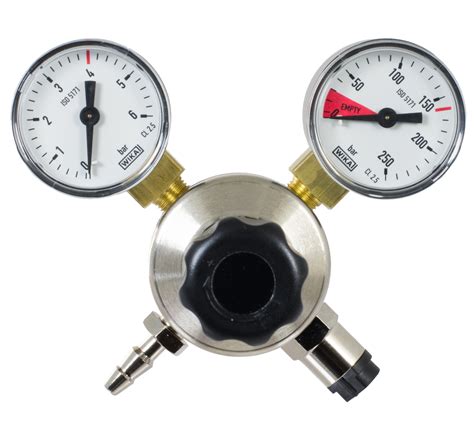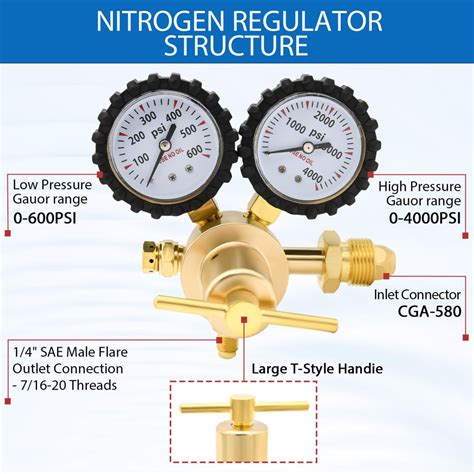The use of nitrogen regulators is a crucial aspect of various industrial and laboratory processes, where the precise control of gas pressure is essential. Nitrogen, being an inert gas, is widely used in applications such as welding, cutting, and purging, as well as in the food and beverage industry for packaging and preservation. A nitrogen regulator, also known as a nitrogen gas regulator, is a device designed to regulate the pressure of nitrogen gas from a high-pressure source, such as a cylinder or tank, to a lower pressure suitable for the specific application.
Primary Function and Importance of Nitrogen Regulators

The primary function of a nitrogen regulator is to reduce the high pressure of the nitrogen gas from the source to a safe and usable pressure for the intended application. This is crucial because high-pressure gases can be dangerous and may damage equipment or cause accidents. By controlling the pressure, nitrogen regulators ensure that the gas is delivered at a consistent and safe pressure, which is essential for achieving the desired results in various industrial and laboratory processes. For instance, in welding and cutting applications, a consistent gas pressure is necessary to maintain the quality of the weld or cut.
Key Points
- Nitrogen regulators are essential for controlling the pressure of nitrogen gas in various industrial and laboratory applications.
- The primary function of a nitrogen regulator is to reduce high-pressure nitrogen gas to a safe and usable pressure.
- Consistent gas pressure is crucial for achieving the desired results in applications such as welding, cutting, and packaging.
- Nitrogen regulators must be selected based on the specific requirements of the application, including the inlet pressure, outlet pressure, and flow rate.
- Regular maintenance and inspection of nitrogen regulators are necessary to ensure safe and reliable operation.
Types of Nitrogen Regulators
There are several types of nitrogen regulators available, each designed to meet specific application requirements. These include single-stage regulators, two-stage regulators, and high-flow regulators. Single-stage regulators are the most common type and are suitable for most applications, while two-stage regulators offer more precise control and are often used in applications where the gas pressure needs to be very consistent. High-flow regulators, on the other hand, are designed for applications where a high volume of gas is required.
| Type of Regulator | Description | Application |
|---|---|---|
| Single-Stage Regulator | Reduces high-pressure gas to a safe and usable pressure in a single step | General-purpose applications, such as welding and cutting |
| Two-Stage Regulator | Reduces high-pressure gas to a safe and usable pressure in two steps, offering more precise control | Applications requiring precise gas pressure control, such as laboratory research |
| High-Flow Regulator | Designed for high-volume gas applications, offering a high flow rate and fast response time | Applications requiring a high volume of gas, such as large-scale industrial processes |

Technical Specifications and Selection Criteria

When selecting a nitrogen regulator, several technical specifications and selection criteria must be considered. These include the inlet pressure, outlet pressure, flow rate, and materials of construction. The inlet pressure is the pressure of the nitrogen gas at the input of the regulator, while the outlet pressure is the pressure of the gas at the output. The flow rate is the volume of gas that the regulator can deliver per unit of time. The materials of construction are also critical, as they must be compatible with the gas being used and the application environment.
In addition to these technical specifications, other selection criteria include the regulator's accuracy, response time, and durability. The accuracy of the regulator refers to its ability to maintain a consistent outlet pressure, while the response time refers to how quickly the regulator can respond to changes in the inlet pressure. The durability of the regulator is also essential, as it must be able to withstand the rigors of the application environment and operate reliably over an extended period.
Regulator Maintenance and Inspection
Regular maintenance and inspection of nitrogen regulators are necessary to ensure safe and reliable operation. This includes checking the regulator for any signs of damage or wear, such as corrosion, scratches, or dents. The regulator’s gauges and valves should also be inspected to ensure that they are functioning properly. Additionally, the regulator should be calibrated periodically to ensure that it is delivering the correct pressure and flow rate.
What is the primary function of a nitrogen regulator?
+The primary function of a nitrogen regulator is to reduce the high pressure of the nitrogen gas from the source to a safe and usable pressure for the intended application.
What are the different types of nitrogen regulators?
+There are several types of nitrogen regulators, including single-stage regulators, two-stage regulators, and high-flow regulators. Each type is designed to meet specific application requirements.
What are the key considerations when selecting a nitrogen regulator?
+When selecting a nitrogen regulator, key considerations include the inlet pressure, outlet pressure, flow rate, and materials of construction. The regulator must be capable of delivering the required flow rate and pressure to ensure safe and efficient operation.
In conclusion, nitrogen regulators play a critical role in various industrial and laboratory applications, where the precise control of gas pressure is essential. By understanding the primary function, types, and technical specifications of nitrogen regulators, as well as the importance of regular maintenance and inspection, users can ensure safe and reliable operation. Whether you are involved in welding, cutting, packaging, or laboratory research, selecting the right nitrogen regulator for your application is crucial for achieving the desired results.



